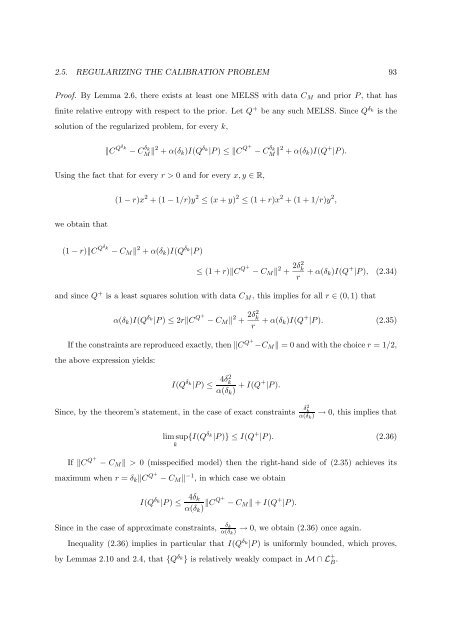Processus de Lévy en Finance - Laboratoire de Probabilités et ...
Processus de Lévy en Finance - Laboratoire de Probabilités et ...
Processus de Lévy en Finance - Laboratoire de Probabilités et ...
You also want an ePaper? Increase the reach of your titles
YUMPU automatically turns print PDFs into web optimized ePapers that Google loves.
2.5. REGULARIZING THE CALIBRATION PROBLEM 93<br />
Proof. By Lemma 2.6, there exists at least one MELSS with data C M and prior P , that has<br />
finite relative <strong>en</strong>tropy with respect to the prior. L<strong>et</strong> Q + be any such MELSS. Since Q δ k<br />
solution of the regularized problem, for every k,<br />
is the<br />
‖C Qδk − C δ k<br />
M ‖2 + α(δ k )I(Q δ k<br />
|P ) ≤ ‖C Q+ − C δ k<br />
M ‖2 + α(δ k )I(Q + |P ).<br />
Using the fact that for every r > 0 and for every x, y ∈ R,<br />
(1 − r)x 2 + (1 − 1/r)y 2 ≤ (x + y) 2 ≤ (1 + r)x 2 + (1 + 1/r)y 2 ,<br />
we obtain that<br />
(1 − r)‖C Qδk − C M ‖ 2 + α(δ k )I(Q δ k<br />
|P )<br />
≤ (1 + r)‖C Q+ − C M ‖ 2 + 2δ2 k<br />
r + α(δ k)I(Q + |P ), (2.34)<br />
and since Q + is a least squares solution with data C M , this implies for all r ∈ (0, 1) that<br />
α(δ k )I(Q δ k<br />
|P ) ≤ 2r‖C Q+ − C M ‖ 2 + 2δ2 k<br />
r + α(δ k)I(Q + |P ). (2.35)<br />
If the constraints are reproduced exactly, th<strong>en</strong> ‖C Q+ −C M ‖ = 0 and with the choice r = 1/2,<br />
the above expression yields:<br />
I(Q δ k<br />
|P ) ≤<br />
4δ2 k<br />
α(δ k ) + I(Q+ |P ).<br />
Since, by the theorem’s statem<strong>en</strong>t, in the case of exact constraints<br />
δk<br />
2<br />
α(δ k )<br />
→ 0, this implies that<br />
lim sup{I(Q δ k<br />
|P )} ≤ I(Q + |P ). (2.36)<br />
k<br />
If ‖C Q+ − C M ‖ > 0 (misspecified mo<strong>de</strong>l) th<strong>en</strong> the right-hand si<strong>de</strong> of (2.35) achieves its<br />
maximum wh<strong>en</strong> r = δ k ‖C Q+ − C M ‖ −1 , in which case we obtain<br />
I(Q δ k<br />
|P ) ≤<br />
Since in the case of approximate constraints,<br />
4δ k<br />
α(δ k ) ‖CQ+ − C M ‖ + I(Q + |P ).<br />
δ k<br />
α(δ k )<br />
→ 0, we obtain (2.36) once again.<br />
Inequality (2.36) implies in particular that I(Q δ k|P ) is uniformly boun<strong>de</strong>d, which proves,<br />
by Lemmas 2.10 and 2.4, that {Q δ k} is relatively weakly compact in M ∩ L + B .
















